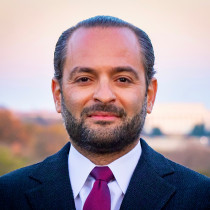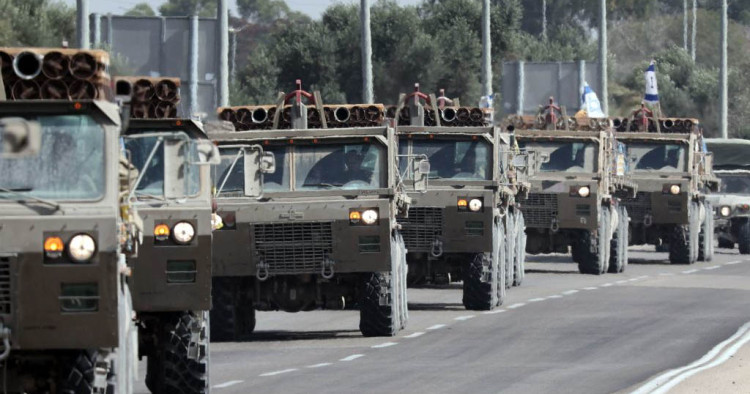Contents:
- Still at square one of a long and dangerous conflict
- As it prepares for Gaza ground offensive, Israel consolidates Western support and hopes for hostage release
- The Biden administration and the humanitarian situation in Gaza: Too little, too late
- Arab governments look worriedly at popular anger over Gaza manifesting in their streets
- In Lebanon, is this the lull before the storm?
- Four competing strategic priorities for the United States in the 2023 Middle East war
Still at square one of a long and dangerous conflict
Paul Salem
President and CEO

-
The Israeli ground offensive, once it starts, is likely to unfold over many months, meaning that the Israel-Hamas war will be with us through the rest of 2023 and, likely, much of 2024; if tensions spread to the Gulf, this conflict will have the potential to severely impact international markets and struggling economies and populations around the globe.
-
Washington is busy trying to limit the fallout from the war; but amidst the inflamed public opinion in the Arab and Muslim worlds, the U.S. will be tied to whatever decisions the Israeli government takes in the coming weeks and months.
As the Hamas-Israel war moves through its third week, the dangers of what still lies ahead continue to loom large. In Gaza itself, the Israeli ground offensive hasn’t even begun. Israel is massing tanks and troops but still has not made clear what the outlines or timing of its ground offensive will be. Meanwhile, it has demanded that half of Gaza’s population move south and is hitting Hamas and other targets from the air. The Israeli ground offensive, once it starts, is likely to be slow — fighting street by street demands it — and unfold over many months. It will take many more civilian lives on the Palestinian side, and probably many lives on the sides of the Israeli military and Hamas forces. It also means that the Israel-Hamas war will be with us through the rest of 2023 and, likely, much of 2024 — mirroring the long trajectory of the ongoing Russian-Ukrainian war.
It is also clear that this is not just a war between Israel and Hamas but in many ways a war between Iran and Israel as well. Although Tehran is not directly involved in a clear way, its support for Hamas and the decisions ultimately made by Hezbollah and other allied militias in Syria, Iraq, and Yemen are very much part of this growing conflict. The highest risk remains the full eruption of a “second front” along the Lebanon-Israel border and, relatedly, along Israel’s border with Syria.
Iranian Foreign Minister Hossein Amir-Abdollahian and Hezbollah have indicated quite clearly that they might open a second front if Israel does not stop its war in Gaza. Their “red lines” are not fully clear, however; there has already been large-scale bloodshed in Gaza, and Hezbollah has escalated along the Lebanon-Israel border, though so far within limits well below opening a second front. Nor is it clear how strongly the messages of deterrence from the United States, as well as the memories of the 2006 war, when both Israel and Lebanon suffered greatly, are holding them back. But there are also concerns that Israel itself might open this front with a pre-emptive strike on Hezbollah — a position apparently voiced by Israeli Defense Minister Yoav Gallant last week.
The U.S. is certainly facing one of its most difficult moments in the wider Middle East in many years. Just weeks ago, it was focused on win-win diplomacy, brokering the India-Middle East-Europe Economic Corridor (IMEC) and working toward a U.S.-Saudi-Israeli normalization agreement that would transform the region and bring the U.S. back to center stage. Now it is busy trying to limit the fallout from the many months of war ahead. The current war has — not surprisingly — inflamed public opinion in the Arab and Muslim worlds, and the U.S. will be tied to whatever decisions the Israeli government takes in the coming weeks and months. Meanwhile, Iranian-allied militias are already harassing U.S. positions in the region, and there will likely be more of that to come.
Iran, Russia, and China all must be satisfied with the regional political reverberations of the war. Iran perhaps has the most to gain — and the most to lose. In its policy of brinksmanship against Israel and the U.S., it might get away with it, if Hezbollah remains intact and Iran or its proxies don’t suffer many losses. But Hamas and Gaza are already paying a heavy price for the attack of Oct. 7, and it is quite possible that Hezbollah and Lebanon might be consumed in a conflict with Israel as well. The higher risk is that these tensions may spill over into the Gulf, either through some form of attack on Iran itself or in a renewed tightening of oil sanctions against Iran.
So far, the conflict has not affected energy prices or the global economy directly; but if conflict spills over into the Gulf, the reverberations of this “local” war will start to severely impact international markets, especially struggling economies and populations around the world — just as the Russian war in Ukraine has done since early 2022.
Follow on Twitter: @paul_salem
As it prepares for Gaza ground offensive, Israel consolidates Western support and hopes for hostage release
Nimrod Goren
Senior Fellow for Israeli Affairs

-
The delay in Israel’s ground operation has enabled it to consolidate Western support for its military objectives; third-party humanitarian efforts are also underway, including for a possible release of additional Israeli hostages held in Gaza.
-
Israeli society continues to mobilize to address the deficiencies of the government, while proving resilient in the face of mounting challenges.
Two and half weeks into the Israel-Hamas war, the internal Israeli debate is dominated by four major issues: support by American and European leaders for Israel and its military objectives; efforts to release Israeli hostages held in Gaza; preparations for the anticipated ground offensive; and societal mobilization to overcome government failures.
Israel’s objective of destroying Hamas’ military and governmental capabilities is supported by multiple American and European leaders, as long as Israel does not intend to reoccupy the Gaza Strip and adheres to international law. Leaders are visiting Israel on an almost daily basis, with President Joe Biden being the most prominent; multiple Western countries have issued joint statements of support; and Western insistence on Israel’s right to self-defense and clear condemnation of Hamas terror impacted the outcome of the “Cairo Summit for Peace“ on Oct. 21.
Western support is not limited to statements, but also includes concrete military assistance, especially from the U.S. (including the interception of Houthi missiles fired toward Israel), and mediation efforts to advance the release of the 200-plus Israeli hostages held in Gaza. Hostage release is easier to negotiate before the launch of an Israeli ground offensive, and the U.S. and Qatar are playing a key role in facilitating this. Two hostages with dual Israeli and American citizenship have already been released, and the hope in Israel is that many more will follow soon.
Israel is delaying the launch of its ground offensive as a result, but this is a delicate balancing act that cannot be prolonged much longer, due to both operational and domestic calculations. In the meantime, Israel has given the green light to the entry of humanitarian aid to the Gaza Strip through Egypt’s Rafah border crossing. It is also concerned about the rise in antisemitic incidents internationally and is baffled by the refusal of some of its presumed allies to condemn Hamas’ actions — both in the Middle East as well as in Western academic, civil society, and media circles.
Domestically, anger at Prime Minister Benjamin Netanyahu and his government is mounting. The prime minister has yet to take any responsibility for what happened, has not addressed the public effectively, and seems to be focused on his own political survival. Moreover, his government is not providing the necessary support to those Israelis impacted by the war, and this vacuum continues to be filled — in growing intensity — by civil society initiatives.
Despite the deep sorrow for the immense losses and uncertainty over what will happen next, the Israeli discourse is characterized by a strong sense of resilience, capability, national pride, and even hope. It is a game changing moment that has shattered the status quo and — if acted upon wisely — could bring new opportunities for a better future.
Follow on Twitter: @GorenNimrod
The Biden administration and the humanitarian situation in Gaza: Too little, too late
Khaled Elgindy
Senior Fellow, Director of Program on Palestine and Palestinian-Israeli Affairs

-
Seventeen days of relentless airstrikes along with Israel’s cut-off of water, food, fuel, and medical supplies to Gaza’s population of 2.2 million have already created the worst humanitarian disaster Palestinians have faced since 1967.
-
Alarmingly, the U.S. administration appears to be considering an Israeli plan for the forcible relocation of Gaza Palestinians to Egypt, which both Egyptian and Palestinians leaders have firmly rejected.
As the world awaits what seems like an imminent Israeli ground invasion of Gaza, 17 days of relentless airstrikes along with Israel’s cut-off of water, food, fuel, and medical supplies to its population of 2.2 million have already created the worst humanitarian disaster Palestinians have faced since 1967. Thus far, Israel’s ferocious aerial bombardment has killed more than 5,000 Palestinians, including over 2,000 children, with more than 165,000 homes destroyed or damaged and a staggering 1.4 million internally displaced. Since the outbreak of the war on Oct. 7, “An unprecedented catastrophe is unfolding before our eyes,” warned one United Nations official. “Gaza is being strangled and the world seems to have lost its humanity.” The situation is likely only to get worse following Israel’s order for the total evacuation of civilians from northern Gaza, warning that anyone who remains will be considered a “partner in a terrorist organization.”
Whereas the Biden administration has lent unqualified support for Israel’s military campaign in Gaza, it has been slow to acknowledge the humanitarian disaster unfolding in Gaza. President Joe Biden has pledged more than $10 billion in additional military support to support Israel’s war effort, while allocating only $100 million for humanitarian aid to Palestinians. Despite the massive civilian death toll and unprecedented scale of destruction in Gaza, the administration has repeatedly rejected calls for a ceasefire and even vetoed a United Nations Security Council resolution put forth by Brazil calling for “humanitarian pauses” to allow lifesaving aid to reach Gaza’s population. Under U.S. pressure, Israel has allowed 34 truckloads of food, medicine, and humanitarian supplies, a tiny fraction of the 100 trucks a day U.N. officials say are needed to meet the urgent needs of Gaza’s population. However, neither U.S. nor European officials have challenged Israel’s decision to cut Gaza off from food, water, fuel, and medicine, which is considered a form of collective punishment and a war crime.
While U.S. officials have made tepid calls for Israel to abide by the laws of war, human rights groups like Amnesty International say “Israeli forces have shown a shocking disregard for civilian lives.” Some rights defenders have raised the specter of genocide. Perhaps as alarming, the administration appears to be considering an Israeli plan for the forcible relocation of Gaza Palestinians to Egypt, which both Egyptian and Palestinians leaders have firmly rejected. Given Washington’s reluctance to call for a ceasefire or to lay out any red lines for Israel’s conduct of the war, however, such scenarios may not be far off.
Follow on Twitter: @elgindy_
Arab governments look worriedly at popular anger over Gaza manifesting in their streets
Dana El Kurd
Non-Resident Scholar

-
The fact that Arab societies care about Palestinians should not have been a surprise; what made the latest wave of mass protests across Egypt, Bahrain, the UAE, and elsewhere notable was that it broke barriers even in states with highly repressive regimes.
-
None of these governments are accountable to their publics, and the feedback mechanism between them and their societies is virtually nonexistent on foreign policy; however, Arab governments understand that Palestine is often a gateway to broader dissent and mobilization, which can turn eventually turn on them.
Protests have erupted across the Arab world in response to Israel’s attack on Gaza. In particular, the scenes from the al-Ahli Arab Hospital bombing went viral, prompting outrage and mass protests in a number of Arab countries. The fact that Arab societies care about Palestinians should not have been a surprise; after all, studies have repeatedly corroborated this fact. In the latest survey iteration of the Arab Opinion Index, for example, 76% of Arab respondents from 14 different countries agreed that the “Palestinian cause concerns all Arabs, and not just the Palestinians alone.”
Instead, what made this latest wave of protests notable was that it broke barriers even in states with highly repressive regimes. For instance, for the first time since the 2013 coup, Cairo’s Tahrir Square witnessed mass mobilization as thousands of pro-Palestine demonstrators came out to voice their anger. Even in countries that have recently signed normalization deals with Israel, such as Bahrain and the United Arab Emirates, we saw dissent and protest. Bahrainis gathered repeatedly in the streets of Manama, in front of the Israeli embassy, and all across the country to call for a reversal of the Abraham Accords. An Emirati writer penned a strong op-ed in a local newspaper decrying what was happening in Gaza — a rare occurrence in a country where pro-Palestinian sentiment has been suffocated. In Jordan, thousands flooded the streets in the aftermath of the hospital massacre, some making their way to the border.
To be clear, none of these governments are accountable to their publics, and the feedback mechanism between them and their societies is virtually nonexistent on foreign policy. Arab outrage that led to these protests thus may not drastically change official policy in the short term.
But that does not mean these protests are inconsequential. Arab governments understand that Palestine is often a gateway to broader dissent and mobilization, as they politicize participants and help build tactical skills in political opposition. We have seen this corroborated in widely variant contexts, from Egypt to Qatar. Moreover, Arab governments recognize that the protests we are seeing are not only in response to Israel’s assault but also a pointed message to themselves. Protesters are angry at what they see as their own government’s lack of action at best, or complicity at worst. This explains why, fearing greater public outrage, the Jordanian king and the Egyptian president canceled their summit with U.S. President Joe Biden last week.
If the attack on Gaza is allowed to continue, perhaps even reaching its most extreme point — population transfer — this will be a great source of instability to Arab governments not only because of the other actors that might become involved in actual warfare but also because of the potential for mass mobilization against regimes in a way we have not seen for years.
Follow on Twitter: @danaelkurd
In Lebanon, is this the lull before the storm?
Firas Maksad
Director of Strategic Outreach, Senior Fellow

-
If Israel makes headway in dismantling Hamas’ military infrastructure, Hezbollah and other Iran-backed militant groups will almost certainly step up their offensive operations.
-
Another escalatory pathway is the real possibility of battlefield miscalculations on the Lebanese-Israeli border, the likelihood of which is growing as Hezbollah attacks and Israeli return-fires increase in both geographic scope and intensity.
On Sunday, Oct. 22, Israeli Prime Minister Benjamin Netanyahu threatened Hezbollah with “crippling it with a force it cannot even imagine,” if the Iran-backed militant group launches a war from Lebanon. Nonetheless, after much anxiety about the Israel-Hamas war in Gaza spilling over to a second front with Hezbollah on Israel’s northern border, there appears to be some relief that the cross-border conflict remains relatively contained for now. This might prove to be the lull before the storm though, particularly as Iran and Hezbollah initiate multiple fronts against Israel and the United States, including Syria, Iraq, Yemen, and of course Lebanon. These fronts will only become more active in the days ahead.
Hezbollah is clearly not eager for what would surely be a devastating war with Israel, but it may find itself compelled to do more as battlefield realities change. One possible inflection point might arrive soon after the Israeli army commences its ground operations in Gaza. If Israel makes significant headway in achieving its stated objective of dismantling Hamas’ military infrastructure, Hezbollah and other Iran-backed militant groups in the region will almost certainly step up their offensive operations. Their aim will be to divert Israeli military resources and relieve Hamas. Whether that remains below the threshold of an all-out Hezbollah-Israel war will depend on several factors, including the magnitude of their operations and that of Israel’s retaliatory strikes.
Another escalatory pathway, irrespective of the impeding Gaza incursion, is the real possibility of battlefield miscalculations on the Lebanese-Israeli border. Although still within the tacit rules of engagement established between the two parties since the 2006 war, Hezbollah attacks and Israeli return fire have progressively increased in both geographic scope and intensity. As the risky messaging through live fire continues, the likelihood of inadvertent errors increases. Errant strikes that cause mass civilian causalities by either side will force both parties up the escalatory ladder and closer to a devastating war.
Beyond the Lebanon front, and despite attempts by the United States to deter it, Iran has clearly decided to expand the scope of its involvement, with Iranian-backed militias carrying out attacks against American forces in Syria and Iraq and launching missiles at Israeli targets from as far away as Yemen. Each of these attacks carries inherent risks of further escalation, particularly if the Biden administration makes good on its threats and underscores its message of deterrence with a firm military response.
On this 40th anniversary of Hezbollah’s bombing of the U.S. Marine Barracks in Beirut, will the two be drawn into direct conflict once again as American warships loom off the Lebanese coast? We are not there yet, but we are moving closer to it rather than farther away.
Follow on Twitter: @FirasMaksad
Four competing strategic priorities for the United States in the 2023 Middle East war
Brian Katulis
Vice President of Policy

-
The Biden administration is currently trying to achieve four goals at the same time: support Israel’s self-defense and objective of eliminating threats posed by Hamas and other groups; secure the safe return of hostages and U.S. citizens trapped in Gaza; prevent a wider regional war; and protect civilians and respond to a growing humanitarian crisis in Gaza.
-
As events unfold, the United States will face tensions between achieving progress on these four goals while engaging the broader Middle East with an integrated diplomatic and security strategy that prevents a wider conflagration.
This past week was a difficult one for the Biden administration to “put diplomacy first” in its engagement in the Middle East as the death toll mounted and tensions escalated across the region. The latest Israel-Hamas war has already been deadlier for Palestinians and Israelis in its first two weeks than the totality of all of the previous episodes of conflict in Gaza since Israel withdrew its troops from the coastal strip in 2005 and imposed a blockade intended to prevent the sort of security threats that emerged in the vicious attack on Oct. 7.
During the past week, United States President Joe Biden traveled to Israel to send a message of support while also working to shape and influence Israel’s decision-making in the next phase. In addition, a bipartisan delegation of U.S. senators visited Saudi Arabia and stopped in Israel. The U.S. military stepped up its presence and levels of alert around the region in the face of attacks and threats emanating from Iraq, Syria, Lebanon, and Yemen. In addition, U.S. diplomats worked intensively to find a pathway toward resolving tensions between urgent crises like trying to help free hostages and safely get hundreds of American citizens out of Gaza, while also enabling humanitarian aid shipments to get in.
The Biden administration is currently trying to achieve four goals at the same time:
- Support Israel’s self-defense and objective of eliminating threats posed by Hamas and other groups
- Secure the safe return of hostages and American citizens trapped in Gaza;
- Prevent a wider regional war; and
- Protect civilians and respond to a growing humanitarian crisis in Gaza.
Israel may have slowed the anticipated ground offensive by its military into the Gaza Strip this past week to buy more time for hostage negotiations and allow for more military reinforcements to deter against a wider regional war threatened by Iran and its proxy network. But Israel’s air campaign is already having a devastating impact. The growing concerns about the lack of protections for Palestinian civilians in Gaza as the death toll rises are reverberating through the wider Middle East as Arab leaders call for a ceasefire and de-escalation, something that is at odds with the U.S. policy of backing Israel’s defense against terrorist threats.
The U.S. response to the current Middle East crisis is impacted by how it deals with Russia’s war against Ukraine, strategic challenges from a rising China, and political dysfunction and gridlock at home. The current crisis will likely shape and define America’s relationship with the region for years to come.
Follow on Twitter: @Katulis
Photo by THOMAS COEX/AFP via Getty Images
The Middle East Institute (MEI) is an independent, non-partisan, non-for-profit, educational organization. It does not engage in advocacy and its scholars’ opinions are their own. MEI welcomes financial donations, but retains sole editorial control over its work and its publications reflect only the authors’ views. For a listing of MEI donors, please click here.













